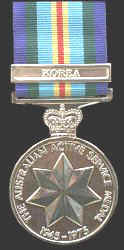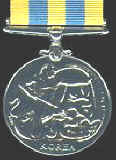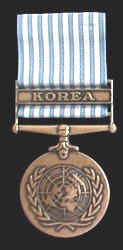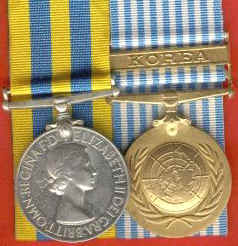 |
| Category:
Conflicts/Others |

|
|
|
|
|
|
The Royal Australian
Regiment in Korea |
|
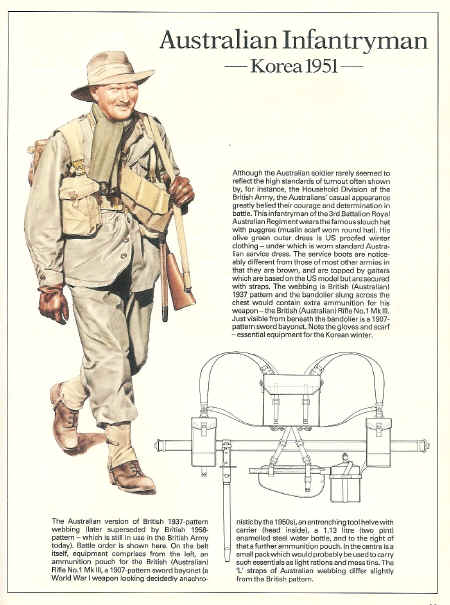
A Digger circa 1952,
Korea
|

Sub category index
|
|
Korean War
Nominal Roll
The Nominal Roll of Australian Veterans of
the Korean War honours and commemorates the men and women who served in the
Royal Australian Navy,
|
|
Australian Army and Royal Australian Air Force in
Korea, or in the waters adjacent to Korea, during the conflict and after the
ceasefire, between 27 June 1950 and 19 April 1956.
This site contains information from the
service records of more than 17,000 individuals who served during the Korean
War.
|
In June 1950 the armed
forces of communist North Korea streamed south to invade the Republic of
Korea.
The Australian Government responded promptly to the UN Security
Council's appeal for support in repelling the communist invasion by ordering
her ground, air and naval forces based in Japan as part of British
Commonwealth Occupation Force (BCOF) to mobilise immediately.

The first element of the
Australian ground forces contingent - the 3rd Battalion of the Royal
Australian Regiment (3RAR)
- arrived in Korea on 28 September 1950. At that point in the war the
United Nations forces had been forced back to the Pusan Perimeter where
they were fighting a desperate battle for survival; it was not
long before the Australians were in the thick of the
fighting as part of the newly formed Commonwealth Brigade. Over
the next few weeks the Battalion played it's part in the United Nations'
counter-offensive and on 17 October it scored a notable
victory at the battle for Sariwon where nearly 2000 North Koreans were
captured.
The Chinese counter-attack was as
much a surprise for the Australians as it was for the other UN forces,
and on 5 November the 3rd Battalion fought its first encounter the
Chinese Army. As part of the general withdrawal
southward, during the winter of 1950-51 the dogged resistance displayed
by the Australian troops won the respect of friend and foe alike. Once
the UN line stabilised the Australian infantry were engaged
in a defensive role, safe guarding the UN positions against
Chinese attacks.
The communist spring offensive
in April 1951 saw some of the toughest fighting of
the war. and in the battle north of Kapyong the
3rd Battalion - with
other British and Commonwealth units - particularly distinguished
itself, to the extent of winning a coveted US Presidential citation for
outstanding gallantry.
From the summer of 1951 the
fighting settled down to a static war of trenches and barbed wire. The
rough terrain and bitter climate did little to aid morale, but as an
all-volunteer force the Australian contingent was able to maintain its
battle efficiency. The men were drawn from sections of the regular
Australian Army and from recently demobbed veterans of World War 2. As
in other armies, the weapons used were those of World War 2, which for
the infantry were Bren light machine guns, Lee Enfield rifles and the
distinctive Australian Owen sub-machine guns.
 |
 |
 |
| Lee
Enfield Rifle |
Owen
machine carbine |
BREN gun |
By July 1951 the numbers of
Commonwealth troops had increased so that the 3rd Battalion became a
part of the Commonwealth Division. The previous month the Australian
contingent had itself been reinforced by the arrival of the 1st
Battalion, the Royal Australian Regiment, (1RAR)
which like its sister battalion was involved in the positional fighting
that characterised the latter stages of the Korean War. In March 1953
the 1st Battalion (1RAR)
was replaced by the newly arrived 2nd Battalion, (2RAR)
though "Old Faithful" 3RAR
still continued to fight on in the line. At this stage the war was
drawing to a close and on 27 July the armistice agreement was signed.
During the course of the war a total of 10,557 Australian ground troops
had been deployed in Korea and had suffered 1396 casualties.
As in World War 2, the Australians
proved themselves to be an effective and successful fighting force,
achieving results out of all proportion to the numbers engaged. |
| Campaign
& Service Medals awarded to Australian troops engaged in the Korean
War |
|
 US Presidential
Unit Citation (Army)
US Presidential
Unit Citation (Army)
(awarded
to 3RAR for the battle of Kapyong)
1. Description: The Presidential Unit Citation emblem worn to
represent award of the Presidential Unit Citation
2. Criteria:
The Presidential Unit Citation is awarded to units of the Armed Forces
of the United States and co-belligerent nations for extraordinary
heroism in action against an armed enemy occurring on or after 7
December 1941. The unit must display such gallantry, determination, and
esprit de corps in accomplishing its mission under extremely difficult
and hazardous conditions as to set it apart and above other units
participating in the same campaign. The degree of heroism required is
the same as that which would warrant award of a (US)
Distinguished Service Cross to an
individual.
3. The emblem
is worn by
all members of a cited organization and is considered an individual
decoration for persons in connection with the cited acts and may be worn
whether or not they continue as members of the organization. Other
personnel may wear this decoration while serving with an organization to
indicate the unit has been awarded the Presidential Unit Citation.
|
|
Distinguished Unit Citation
The
Distinguished Unit Citation was redesignated the Presidential Unit
Citation (Army) 3 November 1966.
3d Battalion, Royal
Australian Regiment (23 and 24 April 1951) 2d Battalion,
Princess Patricia's Canadian Light Infantry (24 and 25 April 1951)
Company A, 72d Heavy Tank Battalion (United States) (24 and 25 April
1951)
The above units are cited for extraordinary heroism
and outstanding performance of combat duties in action against the armed
enemy near Kapyong, Korea, on the dates indicated. The enemy had broken
through the main line of resistance and penetrated to the area north of
Kapyong. The units listed above were deployed to stem the assault. The
3d Battalion, Royal Australian Regiment moved to the right flank of the
sector and took up defensive positions north of the Pukhon River. The 2d
Battalion, Princess Patricia's Canadian Light Infantry, defended in the
vicinity of Hill 677 on the left flank. Company A, 72d Heavy Tank
Battalion, supported all units to the full extent of its capacity and,
in addition, kept the main roads open and assisted in evacuating the
wounded. Troops from a retreating division passed through the sector
which enabled enemy troops to infiltrate with the withdrawing forces.
The enemy attacked savagely under the clangour of bugles and trumpets.
The forward elements were completely surrounded going through the first
day and into the second. Again and again the enemy threw waves of troops
at the outer defences, but each time the courageous, indomitable, and
determined soldiers repulsed the fanatical attacks. Ammunition ran low
and there was no time for food. Critical supplies were dropped by air to
the encircled troops, and they stood their ground in resolute defiance
of the enemy. With serene and indefatigable persistence, the gallant
soldiers held their defensive positions and took heavy toll of the
enemy. In some instances when the enemy penetrated the defences, the
commanders directed friendly artillery fire on their own positions in
repelling the thrusts. Toward the close of 25 April, the enemy
break-through had been stopped. The seriousness of the break-through on
the central front had been changed from defeat to victory by the gallant
stand of these heroic and courageous soldiers. The
3d Battalion, Royal Australian Regiment;
2d Battalion, Princess
Patricia's Canadian Light Infantry; and Company A, 72d Heavy Tank
Battalion, displayed such gallantry, determination, and esprit-de-corps
in accomplishing their missions under extremely difficult and hazardous
conditions as to set them apart and above other units participating in
the campaign, and by their achievements they brought distinguished
credit on themselves, their homelands, and all freedom loving nations. |
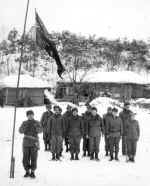 |
Australian
soldiers are standing to attention in their snow covered camp during the
Korean War in 1951. The Australian flag is being hoisted by W.J.
Harrison. |
|
British 1st Commonwealth
Division |
| The British 1st
Commonwealth Division was a formation that took part in the
Korean War. It was formed in July 1951 from British, Australian,
Canadian and other Commonwealth units involved in the conflict. It was
deactivated in 1954 as part of the draw-down of forces in Korea in the
aftermath of the war. |
Commanding Officer
- Major General James Cassels 28 July
1951-7 September 1952
- Major General Michael Alson-Roberts-West
7 September 1952-1953
Divisional Artillery Commanding
Officer
- Brigadier William Pike July
1951-1952
- Brigadier G Gregson 1952
Order of Battle
- Headquarters and Headquarters Company 1st
Commonwealth Division
- 1st Commonwealth Division Signals, July
1951-July 1953
- 45th Field Regiment, Royal Artillery,
July-November 1951
- 11th (Sphinx) Battery, Royal Artillery,
July-November 1951
- 170th Light Battery, Royal Artillery,
July-November 1951
- 14th Field Regiment, Royal Artillery, November
1951-December 1952
- 120th Light AA Battery, Royal Artillery,
October 1951-December 1952
- 42nd Light AA Battery, Royal Artillery,
November 1951-February 1952
- 61st Light Field Regiment, January 1952-July
1953
- 20th Field Regiment, Royal Artillery, December
1952-July 1953
- 16th Field Regiment, Royal New Zealand
Artillery, July 1951-July 1953
- 2nd Regiment, Royal Canadian Horse Artillery,
July 1951-May 1952
- 1st Regiment, Royal Canadian Horse Artillery,
May 1952-April 1953
- 81st Field Regiment, Royal Canadian Artillery,
April 1953-July 1953
- 1903 Independent Air Observation Post Flight,
Royal Artillery, July 1951-July 1953
- 28th Field Engineer Regiment, Royal Engineers,
July 1951-July 1953
- 64th Field Park Squadron, Royal Engineers, July
1951-July 1953
- 8th King's Royal Irish Hussars, July
1951-December 1951
- C Squadron, 7th Royal Tank Regiment, July
1951-October 1951
- 5th Royal Inniskilling Dragoon Guards, December
1951-December 1952
- 1st Royal Tank Regiment, December 1952-July
1953
- 25th Canadian Infantry Brigade
- 1st Battalion, The Royal
Canadian Regiment, April 1952-March 1953
- 2nd Battalion, The Royal
Canadian Regiment, July 1951-April 1952
- 3rd Battalion, The Royal
Canadian Regiment
- 1st Battalion, Princess
Patricia's Canadian Light Infantry, Oct 1951-Nov 1952
- 2nd Battalion, Princess
Patricia's Canadian Light Infantry, July 1951-Nov 1952
- 3rd Battalion, Princess
Patricia's Canadian Light Infantry, March 1953-July 1953
- 1st Battalion, Royal 22e
Regiment, April 1952-April 1953
- 2nd Battalion, Royal 22e
Regiment, July 1951-April 1952
- 3rd Battalion, Royal 22e
Regiment, April 1953-July 1953
- 28th British Commonwealth
Infantry Brigade
- 1st Battalion, The King's
Own Scottish Borderers, July 1951-August 1952
- 1st Battalion, The King's
Own Shropshire Light Infantry, July 1951-Sep 1952
- 1st Battalion, The Royal
Fusiliers, August 1952-July 1953
- 1st Battalion, The Durham
Light Infantry, September 1952-July 1953
- 1st Battalion, The Royal
Australian Regiment, March 1952-March 1953
- 2nd Battalion, The Royal
Australian Regiment, July 1951-March 1952
- 3rd Battalion, The Royal
Australian Regiment, March 1951-July 1953
- 29th British Infantry
Brigade
- 1st Battalion, The Royal
Northumberland Fusiliers, July 1951-October 1951
- 1st Battalion, The
Gloucestershire Regiment, July 1951-November 1951
- 1st Battalion, The Royal
Ulster Rifles, July 1951-October 1951
- 1st Battalion, The Royal
Norfolk Regiment, October 1951-September 1952
- 1st Battalion, The
Leicestershire Regiment, October 1951-June 1952
- 1st Battalion, The Welch
Regiment, November 1951-November 1952
- 1st Battalion, The Black
Watch, June 1952-July 1953
- 1st Battalion, The King's
Regiment, September 1952-July 1953
- 1st Battalion, The Duke of
Wellington's Regiment, September 1952-July 1953
- 1st Battalion, The Royal
Scots, July 1953
|
|
Canada in Korea |
|
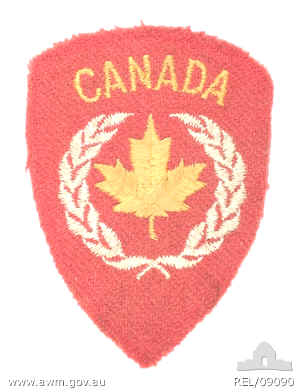
|
Canadian infantry units
first went into action in Korea in February 1951, when 2 Battalion,
Princess Patricia's Canadian Light Infantry (2 PPCLI) joined 27
Commonwealth Infantry Brigade. This unit remained with 27 Brigade until
May, when it was withdrawn to join 25 Canadian Brigade on its arrival in
Korea. The new all-Canadian formation fought for the remainder of the
war, and included, in rotation, the following units: 1, 2, and 3
Battalions, The Royal Canadian Regiment (RCR); 1, 2, and 3 Battalions,
Princess Patricia's Canadian Light Infantry (PPCLI); 1, 2, and 3
Battalions, Royal 22e Regiment; 2 Battalion The Black Watch (Royal
Highland Regiment) of Canada; 2 Battalion The Queen's Own Rifles of
Canada and 4 Battalion, The Canadian Guards. A, B and C Squadrons of
Lord Strathcona's Horse (2 Armoured Regiment, Royal Canadian Armoured
Corps) and D Squadron The Royal Canadian Dragoons (1st Armoured
Regiment, Royal Canadian Armoured Corps) also served in the brigade, as
well as artillery, engineer, signals and service corps units. The
Canadian forces suffered some 1471 casualties during the war. |

|

